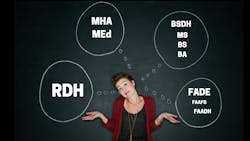Write it right: RDH is not a degree
Should there be a consensus on how we display our professional credentials?
There is no dental hygiene program that issues an “RDH degree.” Entry-level dental hygiene educational institutions that are accredited by the Commission on Dental Accreditation grant associate in applied science (AAS) degrees in dental hygiene. Many programs also offer bachelor of science in dental hygiene (BSDH) degrees and the master of science degree in dental hygiene (MSDH). In the future, a doctorate degree in dental hygiene (DDH) may be offered. But hygienists earning any of these degrees do not come away with an “RDH degree.”
Where did the idea of placing the RDH credential after one’s name come from? Who started it? If someone can answer this, I would ask that they enlighten us all. It may be that we followed the example of registered nurses, RNs. Even that is not a degree but the name of the profession. I understand the sense of pride and belonging when we display our credentials, but what is the protocol for the letters we add after our names? In other words, just what is the proper way to list our degrees, licenses, and credentials?
The fact that jurisdictional statutes require dental hygienists to maintain an active or registered status does not reflect our educational degree. If you practice dental hygiene or not, you’re either required or choose to keep the license active or registered. What does licensure mean? It means that a licensing agency vouches for your education and competence, hence the DH (dental hygienist), RDH (registered dental hygienist), or LDH (licensed dental hygienist). These letters tell the profession that you have authority and certification to practice.
So why do we write "RDH" after our names?
What does this certification mean? In the context of adding letters after our names, it's a display to show that a professional body has determined that skills and knowledge have been attained and we have the right to announce it.
How do you identify yourself? If you identify first as a hygienist, you’re likely to sign your name on letterheads, business cards, and emails with the RDH after your name. But there are accepted guidelines that contradict this practice.
These accepted guidelines for listing degrees, licenses, and credentials may have become blurred in dental hygiene. Why do we write RDH after our names? Why are we confused? Where did this misuse originate? It is probably fruitless and inconsequential to devote time to answering these questions, but it’s not too late to correct the way we write the letters after our names.
More and more hygienists are earning advanced degrees. We are earning these in several different disciplines in addition to dental hygiene. The American Dental Hygienists' Association posts 14 states are now offering a master's degree in dental hygiene.1 They will have additional letters to place after their names.
What we need is clarity and uniformity that exhibit correctness. We should do this for that elusive credibility that we want, but most important, for our profession. Think of the public confusion when they don’t understand the meaning of all those letters. The American Nurses Credentialing Center, a subsidiary of the American Nursing Association, states, “Having a standard way ensures that everyone, including nurses, health-care providers, consumers, third-party payers, and government officials, understand the significance and value of credentials.”2
There is a National Certification Corporation that tells its clients that specialty certifications are helpful to patients and peers, but a very long list can overpower a name. To be certain, the ones that pertain to the job should be displayed. If you’re being published, you should list all credentials.3
To add to the confusion, some sources, including Careers Done Write, discourage displaying all degrees and credentials on the first line of a résumé. They say only the doctorate degree should be displayed there and other degrees should be placed in the education section and summary.4
Are we being delusional by putting ourselves out there as a profession? We argue with anyone who doesn't refer to dental hygiene as a “profession.” I know I do, yet we weren’t a profession in the eyes of the United States government until 2018; we were “technicians.” From the U.S. Office of Management's Budget 2018 revision of the Standard Occupational Classification, we are now defined as Healthcare Diagnosing or Treating Practitioners group, the same grouping as dentists.5 Credit the American Dental Hygienists’ Association for its tireless work dedicated to this success.
One of the challenges is self-regulation. We need to be autonomous. We’ve made a few strides but we’re not concentrating hard enough to get autonomy. We’re not garnering the support we need in each state to have a board of dental hygiene wherein we regulate dental hygiene to protect the public. We need to work on legislation efforts to facilitate change.
Let’s start writing our credentials right and uniformly to help dispel confusion. Hop on the bandwagon to use a uniform display of credentials to show we’re united in our efforts to recognize the many accomplishments of ourselves and our colleagues. Here's how.
Displaying your credentials, step by step
The American Nursing Association offers a step-by-step guide to displaying credentials, and we should take note of these and adopt its use. We should be uniform in this important reflection of ourselves.
The example they offer using the “step-by-step” method is paraphrased here to apply to dental hygiene.
Here is an example of a hygienist signature: Jane Doe, MS, RDH, FAADH, FAAFS, FADE
Step 1: Education first
Start by listing the highest degree: Jane Doe, MS. Once you earn an educational degree, it will always be a part of your identity. Here you can distinguish the master’s in dental hygiene as MDH if it is your highest dental hygiene degree. If Jane had a master’s degree in education in addition to the master’s in dental hygiene, it would be listed as M.Ed, MDH.
Step 2: Licensure next
Jane Doe, MS, RDH. This is where the licensure should be listed. Jane is a licensed dental hygienist, so this follows the educational degree. It should be listed as RDH or LDH—however your state defines it. It’s interesting to note that in different states we’re referred to as dental hygienists or licensed dental hygienists. New York State defines us as dental hygienists without reference to “registered.”6 Indiana defines us as licensed dental hygienists.7
Step 3: Then specialty
Jane Doe, MS, RDH, FAADH, FAAFS, FADE. Hygienists have attained certification in different fields of study within and outside of dentistry. They are considered industry certifications. The American Academy of Dental Hygiene grants a fellow status. Hygienists have attained certification in myofunctional therapy, lasers, implantology, and more.
Any additional authorities we earn are listed next. These may include FAADH, fellow in American Academy of Dental Hygiene, and FAAFS, fellow in American Academy of Forensic Sciences. Others can be extensive certifications in dental specialties, such as FADIA, fellow in Association of Dental Implant Auxiliaries. All credentials should be separated by commas; periods should not be used.
Editor's note: Originally posted in 2018 and updated regularly
References
1. American Dental Hygienists’ Association https://www.adha.org/education-resources/become-a-dental-hygienist/dental-hygiene-programs/masters-of-dental-hygiene. Accessed February 21, 2023.
2. How to display your credentials. American Nurses Credentialing Center. https://www.nursingworld.org/~4abf5a/globalassets/certification/renewals/DisplayCredentials-Brochure. Accessed June 25, 2018.
3. Credentials can get complicated: Are you displaying your achievements the correct way? National Certification Corporation website. https://www.nccwebsite.org/Credentialscangetcomplicatedareyoudisplayingyourachievementsthecorrectway.aspx. Published August 4, 2017. Accessed June 25, 2018.
4. Wheatman D. Résumé help: The ABCs of credentials on your résumé. https://careersdonewrite.com/blog/resume-help-the-abcs-of-credentials-on-your-resume/. Published August 29, 2013. Accessed June 25, 2018.
5. Federal Registry, Standard Occupational Classification (SOC) System Revision for 2018. https://www.federalregister.gov/documents/2017/11/28/2017-25622/standard-occupational-classification-soc-system-revision-for-2018. Accessed February 19, 2023.
6. Education Law. Article 133, Dentistry and Dental Hygiene [and Certified Dental Assisting.] NYSED.gov website. http://www.op.nysed.gov/prof/dent/article133.htm. Accessed June 25, 2015.
7. A compilation of the Indiana Code and Indiana Administrative Code 2011 Edition. Code 25-13–Dental hygienists. Indiana State Board of Dentistry. https://www.in.gov/pla/files/2011_ISDB(2).pdf. Updated July 11, 2011. Accessed June 25, 2018.
About the Author

Winnie Furnari, MS, RDH, FAADH, FAAFS, FADE
Winnie Furnari, MS, RDH, FAADH, FAAFS, FADE, once served as president of the American Academy of Dental Hygiene. She also served as president of the New York and New Jersey Dental Hygienists Associations and in numerous capacities in professional organizations. She was a clinical professor at NYU College of Dentistry and taught a forensic dentistry/catastrophe preparedness course in the baccalaureate program. Furnari was awarded national and international awards and recognitions for her dental hygiene achievements. As a member of the NY City Dental Identification Team, she participated in several multiple-fatality responses.
